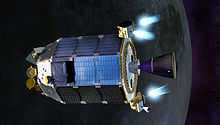Zond 3
| Operator | Soviet Union |
|---|---|
| Major contractors | OKB-1 |
| Mission type | Planetary Science |
| Launch date | July 18, 1965 at 14:38:00 UTC |
| Launch vehicle | SL-6/A-2-e |
| Mission duration | ? |
| Mission highlight |
Fly-by of Moon on July 20, 1965 at distance of 9,200 km |
| Satellite of | Sun |
| COSPAR ID | 1965-056A |
| Homepage | NASA NSSDC Master Catalog |
| Mass | 960 kg |
| Orbital elements | |
| Semimajor axis | 1 AU |
| Eccentricity | 0.2683 |
| Inclination | 0.5° |
| Apoapsis | 1.56 AU |
| Periapsis | 0.9 AU |
| Orbital period | 500 d |
| Instruments | |
|
f/106 mm Camera and TV system with automatic inflight film processing Magnetometer Ultraviolet (0.25–0.35 µm and 0.19–0.27 µm) spectrograph Infrared (3–4 µm) spectrograph Radiation sensors (gas-discharge and scintillation counters) Radiotelescope Micrometeoroid instrument Experimental ion engine | |
Zond 3 was a 1964 space probe sent toward Mars as a spacecraft test. It was a member of the Soviet Zond program sharing designation Zond, while being part of Mars 3MV project. It was unrelated to Zond spacecraft designed for manned circumlunar mission (Soyuz 7K-L1). Zond 3 completed a successful Lunar flyby, taking a number of good quality photographs for its time. It is believed that Zond 3 was initially designed as a companion spacecraft to Zond 2 to be launched to Mars during the 1964 launch window. The opportunity to launch was missed, and the spacecraft was launched on a Mars trajectory as a spacecraft test, even though Mars was no longer attainable.
Spacecraft design
The spacecraft design was similar to Zond 2, in addition to the imaging equipment it carried a magnetometer, ultraviolet (0.25 to 0.35 micrometre and 0.19 to 0.27 micrometre) and infrared (3 to 4 micrometre) spectrographs, radiation sensors (gas-discharge and scintillation counters), a radiotelescope and a micrometeoroid instrument. It also had an experimental ion engine.
Mission

The spacecraft, a Mars 3MV-4A, was launched from a Tyazheliy Sputnik (65-056B) earth orbiting platform towards the Moon and interplanetary space. The spacecraft was equipped with an f/106 mm camera and TV system that provided automatic inflight film processing. On July 20 lunar flyby occurred approximately 39 hours after launch at a closest approach of 9200 km. 23 photographs and 3 ultraviolet spectra of very good quality were taken of the lunar farside from distances of 11,570 to 9960 km over a period of 68 minutes. The photos covered 19,000,000 km² of the lunar surface. Zond 3 proceeded on a Mars trajectory, but not at a time when planetary encounter would occur. To test telemetry, the images were rewound and transmitted at 2.2 million km, 31.5 million km and possibly again at greater distances, thus proving the ability of the communications system. The subsequent transmissions were also at a higher data rate.[1] The mission was ended and radio contact ceased when it was at a distance of 150 million km.
This article was originally based on material from NASA (NSSDC) information on Zond 3
References
- ↑ Teitel, Amy Shira. "Zond 3: First to See Moon's Far Side on the Way to Mars". Discovery News. Discovery Communications. Retrieved 19 July 2013.
External links
| Preceded by Zond 2 |
Zond program (interplanetary) | Succeeded by None |
| ||||||||||||
| |||||||||||||||||||||||||||||||||||||||||||||||||||||||||||||||||||||||||
| ||||||||||


